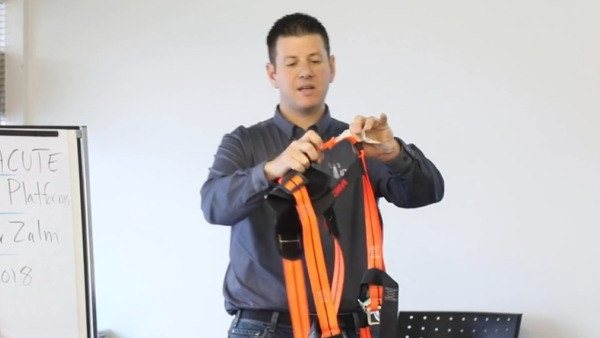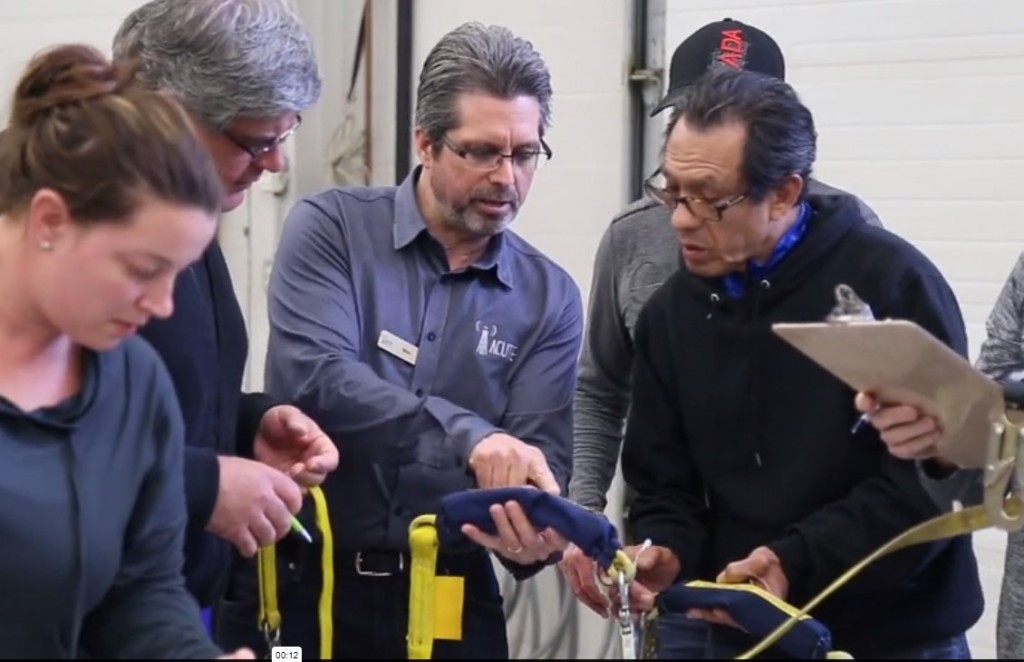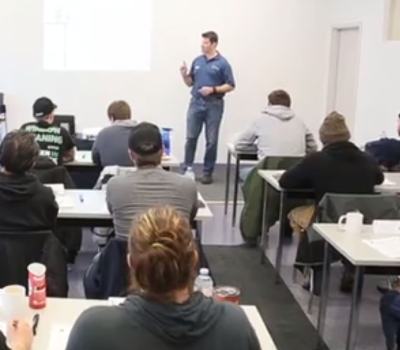Here are some great tips to help you make an effective safety presentation. Click on each tip to learn more.
- Tailor your Presentation to Your Audience
- Do Your Research Beforehand
- Practice and Time Your Presentation
- Give an Overview at the Start
- Use Questions at the Start and Throughout
- Use Good Quality Images and Video to Help Keep Your Listeners Engaged
- Avoid the PowerPoint Deathtrap
- Be Prepared for Questions
If you are looking for profession health and safety training or advice, contact us.
Tips for Making a Great Safety Presentations
A safety presentation can be a great way to present new safety protocols
Giving a safety presentation can be an effective way to communicate the value of workplace safety to an audience, whether they are new or seasoned employees. The more effective the presentation, the more valuable it will be in helping to keep your workers safe. Follow these tips to make your safety presentation both memorable and effective.
1. Tailor your Presentation to Your Audience
Safety presentations are not a one-size-fits-all commodity. You need to consider your audience and tailor your talk to suit their needs.
Involve Experienced Workers: For example if your are training new employees on safety practices, you might want to bring in an experienced worker to give his or her perspective on safety in the workplace.
Use Props: On the other hand, if you are talking about how to safely handle equipment, such as a new fall prevention device, you might want to bring in actual samples of equipment for your audience to try out.

Don’t use industry jargon when presenting to new hires
Avoid Jargon: You probably will want to adjust your choice of words to suit your audience. New hires may not be familiar with industry jargon yet, so you may need to speak in more layman’s terms. However, if your audience is made up of seasoned workers then industry jargon would be fine to use.
2. Do Your Research Beforehand
Make sure you take the time to do your research beforehand and prepare for your safety presentation thoroughly.
Take Time to Prepare: Very few people can make any type of a presentation “off the cuff” and usually if they do, it ends up being too long, boring, or not cohesive. You need to take your time to compile the most important information and come prepared with a clear message.
Use Reliable Sources: Use sources that you can trust for your research. Government websites are a good source of information on health and safety topics.

Research and prepare what you will say for your safety presentation ahead of time
Use Statistics Wisely: Include statistics to back up what you are saying, but use them sparingly. You don’t want to bombard your audience with too many numbers because they will quickly lose interest and stop listening to you.
For example, if you are talking about forklift safety, you could include a statistic about the number of forklift accidents that cause serious injury each year to enforce your point about the importance of proper training.
3. Practice and Time Your Presentation
Practice It Aloud: There is a big difference between reading your notes in your head and actually practicing them aloud ahead of time. It is a great idea to run through what you are going to say before you give your presentation. It will sound differently when you say it aloud than when you just run it through your head.
Make Adjustments: You will better hear areas that need to be improved or that don’t make sense when you read your presentation out loud. Then, you can make the appropriate adjustments before the presentation.
Time your safety presentation and make the necessary adjustments
Adjust the Length: Practicing ahead of time will also give you a good chance to see how long your safety presentation is. If it is too long, you will have time to make the necessary cuts.
Remember that most audiences have a relatively short attention span. The average attention span of an adult is about 18-20 minutes long. After that, your audience will likely start to lose focus.
4. Give an Overview at the Start
Telling your audience what you are going to be including in your presentation is a good way to start off your talk.
List Your Main Headings: Give your audience an overview of the material that you will be covering. In the overview you can outline your main topic and the various sub-topics you plan to cover in your safety presentation.

Explain the topics that you will cover at the start
Display Your Overview: You can show your list of topics on a slide and or give it out as a handout, so they can follow through the main points of your talk. This will make your presentation feel shorter because the people listening will know exactly where you are and where you are going.
5. Use Questions at the Start and Throughout
One great way to keep your audience engaged is by asking questions.
Use Engaging Questions: Start off by asking some questions to engage your audience. For example, you could ask question such as:
- What do you think is the highest cause of injuries in your particular industry?
- What safety advice would you give to a new employee?
- How many lives have been saved by the use of seatbelts?
Use Questions to Gain Back Attention: You can also intersperse questions throughout your talk, to “wake up” your audience if you sense that they are drifting away.

Use questions to gain your audience’s attention
Get Creative: You can get even more creative by having a trivia game, role-playing activity or group problem solving activity to break up your talk and get your audience involved.
6. Use Good Quality Images and Video to Help Keep Your Listeners Engaged
Good quality images and videos will help keep your audience engaged.
Enforce Your Points with Visuals: Images not only help to keep your audience interested, they can also be valuable for showcasing and bringing home your point better.
Engage Multiple Senses: By using images, you are reaching your audience with two senses, listening and seeing instead of just one. This will help them to better recall the material you are presenting.

Use images to help better engage your audience
Use Appropriate Humour: The odd cartoon thrown into your presentation can also help to get your audience’s attention again, especially in the midst of more boring parts of your material. Just make sure that any jokes or cartoons you use are appropriate and in good taste.
7. Avoid the PowerPoint Deathtrap
PowerPoint can be a very powerful tool to help you with your presentation, however it can also be overused.
Don’t Read Your Slides Word for Word: Avoid the temptation to have your entire script written out on your slides and simply getting up and reading them word for word. This type of approach is incredibly boring and will result in your having a totally disengaged and uninterested audience.
Don’t read your safety presentation word for word from your PowerPoint
Only Include Your Main Points: Instead use your slides to simply highlight and drive home your main points. It is better to include your main points on each slide and then you can elaborate on them as you go through your presentation.
8. Be Prepared for Questions
Encourage Questions: Don’t be afraid of questions – in fact, you should encourage them. Listen to your audience’s questions and concerns and allow for follow-up questions.
This type of open dialogue will help to build rapport and trust with your audience and make them much more inclined to listen to what you have shared. In contrast, if you don’t allow for open dialogue and present your material with no chance for questions, you are more likely to get resistance.
Let Your Listeners Voice Their Opinions: If you are presenting new rules and regulations, you should be prepared for questions and complaints. Most people find change hard and so you should anticipate that there will be some resistance. Don’t worry. It’s good to give your listeners time to voice their concerns.

Encourage questions to build rapport and trust with your audience
Think About How You Can Overcome Objections Ahead of Time: If you can anticipate what some or all of their concerns might be ahead of time, you can think through how you can overcome those objections and effectively answer them. Brainstorm a list of possible questions and objections ahead of time and think through how you can respond to them so that you won’t be thrown off-guard.
Why Choose ACUTE for Your Workplace Health and Safety Training
Hands-on, practical training is the best way to keep employers and workers safe in the workplace! ACUTE is dedicated to workplace safety and understands the importance of course and training provider approval.
Why get workplace safety training with ACUTE?
Here are just some of the benefits of working with ACUTE:
- Open Door Instructor-Student Partnership – ACUTE’s training services emphasize client participation, staff foster relationships with clients, and serve as a touchstone for advice anytime moving forward.
- Serving Your Team and Industry – With a vast array of clients in manufacturing, construction, health, academic, and government sectors, ACUTE brings the best safety practices from across the spectrum to your workplace.
- 100 Years Combined Experience – ACUTE provides comprehensive health and safety training, on-site safety services, and consulting services. With over 100 years of combined experience, our company staff offers more than theoretical or abstract ideas. ACUTE offers solutions!
- Track Record of Success – ACUTE has rated 4.9/5 stars on Google reviews, demonstrating a commitment to our clients, quality, and passion for training.
Hours of Operation
Monday – Friday: 8:00am-5:00pm
Saturday – Sunday: Closed

What Our Customers Are Saying…
Acute is recognized and respected as a people organization and they have been doing it right for a long time.
Acute has been a staple in supporting my companies over the years and have always delivered quality amd dependable service. Training programs are top shelf and a great facility for practical application. couldn’t recomend them more. keep up the great work folks.
We were referred to ACUTE on behalf of our employer for an n95 mask fitting – the staff here are professional, personable, and informative.
I’d come back here for any safety-related training in a heartbeat.

